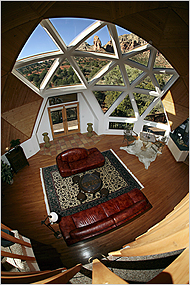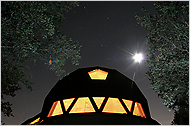The Dome Gains Weight and Settles Down
By ALASTAIR GORDON
Published: January 11, 2007
BRUCE NELKIN decided in the 10th grade that he would someday live in a geodesic dome, after seeing a picture of one in a science book. “It looked like something out of ‘Star Wars,’ ” Mr. Nelkin said. “I thought it was the coolest thing I’d ever seen, and I said to myself, ‘When I grow up I’m going to build one of those.’ ”

Jeff Topping for The New York Times
SUPERSIZE Houses like John and Cindy Schofield’s in Arizona are defying the countercultural image of the dome.
Multimedia

Slide Show
The Geodesic Dome
In 2003 he finally did. Now Mr. Nelkin, 45, an Internet marketer, and his wife, Deana, live in a house made of two adjoining domes in Pleasantville, N.Y.
The pale gray hemispheres stand out like twin spaceships on a tree-lined street where all the other houses have pitched roofs. But inside, the house looks unexpectedly terrestrial, with overstuffed couches, hardwood floors and rustic fireplaces much like those of its neighbors.
The Nelkins are among a growing group of Americans who are building dream homes in the shape of geodesic domes, once a symbol of youthful rebellion but now one of aspiration for aging baby boomers.
Hemispheres are sprouting up among the mock Tudors and colonials of upscale neighborhoods across the country, from Veneta, Ore., where a company called Oregon Dome is building a development of 2,000-square-foot spec domes on suburban lots for around $200,000 each, to Asheville, N.C., where American Ingenuity, a Florida company, is starting to put up an all-dome community. Like tofu and yoga, the dome has evolved from countercultural funkiness to middle-class respectability.
First popularized in the 1950s by the designer and inventor Buckminster Fuller, who died in 1983, geodesic domes have long been appreciated by environmentalists for their energy efficiency and the way they provide the maximum amount of space with a minimum of material. In the 1960s and ’70s, hippies built them in the wilderness, painting them in psychedelic patchworks; their rounded contours were seen as a retort to all things square or right-angled in Western society.
The domes of the Flower Power era were rarely more than a standard 24 feet in diameter and cost less than $1,000 to build, according to Jay Baldwin, an early dome builder and dweller. But many new domes are sprawling mansions of more than 10,000 square feet, built on budgets of a million dollars or more.
“The domes have gotten bigger and more expensive as people’s incomes expanded,” said Dennis Johnson, who founded Natural Spaces Domes, a dome building company in North Branch, Minn., in 1978. In the past decade his clients have quadrupled in number, to about 200 a year.
Like most modern homeowners, dome owners want plenty of space.
“They want another bedroom,” said Robert Singer, the president of Timberline Geodesics, a dome manufacturer in Berkeley, Calif. “They want the home office, they want the entertainment room, they want the extra space in the basement, they want the large custom kitchen.”
Two years ago, Mr. Singer said, his factory needed to run only seven months a year to meet the demand. Now it operates full time to produce more than 50 houses annually, and he still can’t fill all the orders.
Many people are also requesting surprisingly conventional architectural accessories: dormer windows, cedar shingles, carriage lamps, gambrel-roofed entryways.
They want to stand out from the pack, it seems, but not too much; they want to reclaim their youth, but aren’t willing to sacrifice the comforts of middle age. (Mr. Nelkin put a cupola on top of his dome, because, he said, it made the place look “more homey” and less like the kind of basic unembellished dome “you might see in an oil refinery.”)
Companies that sell kits for large-scale domes offer custom options like cupolas, balconies, rectangular additions for extra rooms and even matching minidomes for pets. But early dome builders like Mr. Baldwin see the new customized domes as bastardizations of Fuller’s concept.
“I call them elephant droppings,” he said. “Fuller’s idea was that of a machine-made object, a pure geometry.”
Most dome dwellers are not so picky.
Tina Gerard and Wes Dehnke, who own a 45-foot-diameter dome in River Falls, Wis., love its shape and the triangular framing inside. But when they were planning it they thought the outside looked too naked.
Not anymore.
“The castle turrets give the dome a whole other dimension,” Ms. Gerard said.
